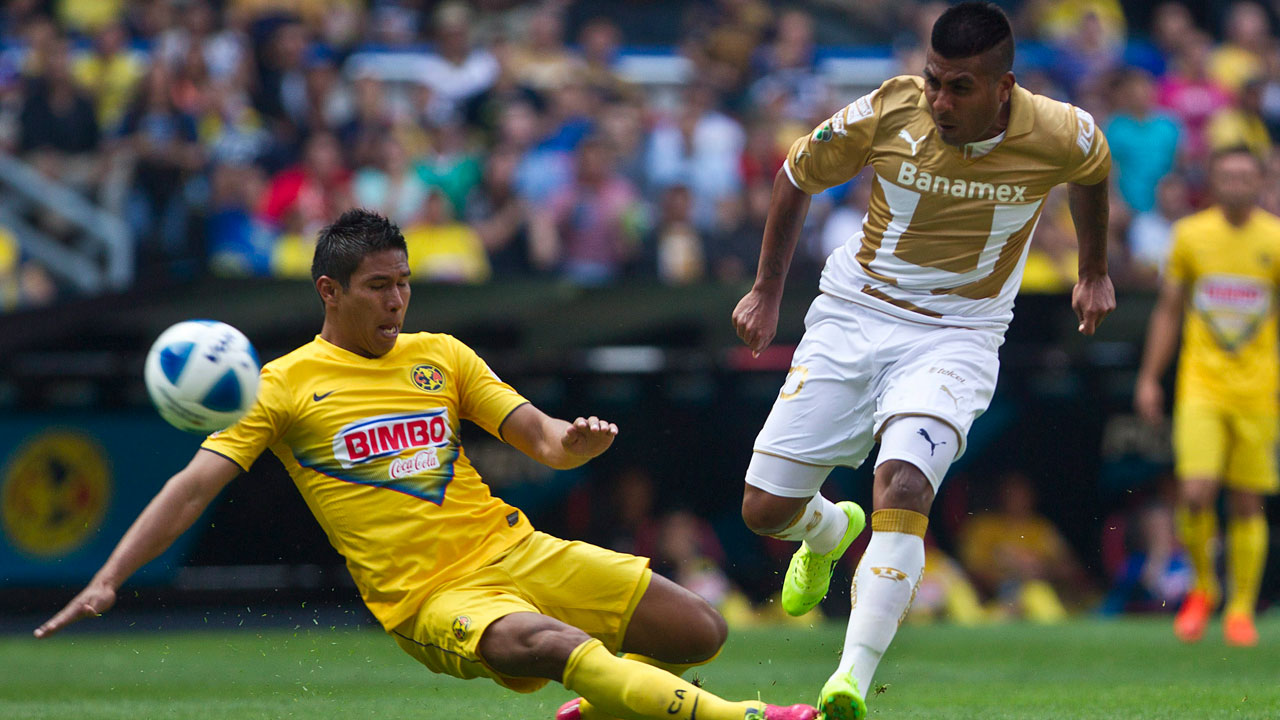MEXICO CITY – When Pumas scored, the Estadio Azteca started raining. From the rafters of the famous stadium, Club America fans began hurling cups, trash and all manner of liquids through the crowd, furious that their cross-town rivals had just taken a 2-1 lead. As I wiped some unidentified substance from my brow, the old man next to me leaned in with some advice:
“If it’s cold, it’s beer. If it’s warm, it’s piss.”
Welcome to derby day in Mexico City.
Before coming to town, a visit to Estadio Azteca had been at the top of my to-do list. A magnificent 105,000-capacity structure standing 2,200 metres above sea level at the southern end of the sprawling nation’s capital, the Azteca might just be the game’s greatest cathedral. It’s the largest soccer-specific stadium in the world, and the only one (until this July, at least) to host two World Cup finals.
It’s also home to some of soccer’s most famous moments. In 1970, Pele’s Brazil produced one of the best team performances in history while sweeping away Italy 4-1 to win the World Cup final. And in 1986 (en route to his own World Cup title), Diego Maradona combined his “Hand of God” with that magical weaving run for two of the most unforgettable goals of all-time during a quarterfinal win over England.
CONCACAF fans know the Azteca as the Mexican national team’s impenetrable fortress, where visitors go to die. But it’s also full every other weekend through the year, when Mexican giants Club America play.
This particular Saturday would be extra spicy. America was hosting cross-town rivals Pumas in the clasico capitalino, the city’s fiercest clash. Like most great world soccer derbies, it’s a rivalry based on identity. America, owned by corporate giant Televisa and traditionally backed by the country’s elite, is Mexico’s biggest, richest, and most hated club.
Pumas, meanwhile, is the kid brother. Officially called Universidad Nacional Autónoma de México (UNAM), and originally founded by students, the club has always belonged to the country’s spirited youth.
By some coincidence, I’d be making my way to the clasico capitalino with another Canadian. I’d been introduced to Caitlin in the city centre that morning. She wanted to come to the stadium. Her first professional soccer game would be at Estadio Azteca.
In a bustling city of over 26 million, the route to the stadium is long and crowded no matter where you’re coming from. From downtown, we took a 30-minute Metro ride to the city’s southernmost station before squeezing in with the excited masses for one more train to the Azteca.
The train doors opened to an endless sea of yellow. Taco stands and pizza stalls lined the walkways and filled the courtyards, while vendors sold America jerseys and hats for sale everywhere you looked. Scalpers roamed around hawking tickets, while men and women young and old loitered about, eating food and drinking beer in anticipation of the fiesta to come.
When an 18-wheeler pulled up to drop of a truckload (literally) of Pumas supporters, America fans greeted them with an intimidating cacophony of base drums, trumpets, and chanting. Inside, the stadium was a cauldron of noise. Thousands of Pumas fans filled the top deck behind one goal, while the rest of the stadium was decked out in America’s yellow.
The match was enthralling: A back-and-forth encounter that ended in a surprising 3-1 Pumas upset—partially aided by the fact that, with the score tied 1-1, America’s captain received a foolish red card for kneeing an opponent in the groin.
But the real show was in the stands: a raucous atmosphere of nonstop singing and chanting, fireworks and flares. The thousands of Pumas fans behind the goal waved giant flags and sang songs all afternoon, while America’s barra brava (supporters’ section) never stopped drumming.
Our section housed both sets of supporters, ensuring maximum levels of animosity. When a Pumas fan below me rose to celebrate his team’s opening goal, an America supporter three rows above him promptly drenched him in beer. When Pumas scored the winner in the second half, the same fan turned and saluted the masses with both middle fingers extended above his head.
After Pumas went ahead 3-1 with 10 minutes to play, disgusted America fans slowly began filing out. Ten minutes after the final whistle, the near-empty Azteca looked a little less impressive: the stands were strewn with trash and soaked in beer (or piss), while workers milled about the pitch.
But derby day wasn’t done yet. Pumas fans remained in the top deck of soccer’s greatest cathedral, proudly chanting away. Beating the big boys on their own patch was huge: they would be singing all the way home and into the night. For the next few days, streets would be filled with gold and white jerseys. Mexico City’s bragging rights had been secured.

